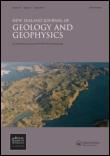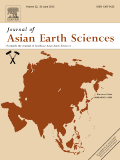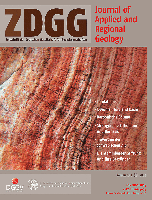
Geodynamics
Scope & Guideline
Pioneering Discoveries in Earth and Planetary Sciences
Introduction
Aims and Scopes
- Geophysical Exploration Techniques:
The journal emphasizes the use of advanced geophysical methods, such as seismic analysis, GNSS measurements, and geomagnetic studies, to investigate subsurface structures and processes. - Geological Modeling and Analysis:
Research often involves the development of geological models, including deep geological models and density distribution functions, to understand the Earth's crust and its dynamic changes. - Natural Hazards and Risk Assessment:
A significant focus is placed on studying natural hazards, including earthquakes and their mechanisms, to assess risks and improve safety in various regions. - Hydrocarbon Exploration and Geodynamics:
The journal addresses the geodynamics of hydrocarbon deposits, exploring their formation, potential, and the geological conditions necessary for their development. - Environmental Geodynamics:
Research includes the impact of geodynamic processes on the environment, such as groundwater contamination and the effects of mining activities on geological stability.
Trending and Emerging
- Advanced Computational Algorithms:
There is a growing trend towards the development of sophisticated algorithms for solving inverse problems in geophysical exploration, reflecting advancements in computational techniques and data analysis. - Real-time Monitoring and Remote Sensing:
The use of satellite data and GNSS technology for real-time monitoring of geodynamic processes, such as crustal deformations and environmental changes, is increasingly prominent, indicating a shift towards more dynamic and responsive research. - Geohazards and Mitigation Strategies:
Research focusing on the prediction and mitigation of geohazards, particularly earthquakes and their impacts, is gaining importance, emphasizing the need for improved risk assessment and disaster preparedness. - Interdisciplinary Approaches to Geodynamics:
Emerging themes show a trend towards interdisciplinary research that integrates geology, geophysics, and environmental science to address complex geodynamic challenges, fostering collaboration across scientific fields. - Sustainable Resource Management:
There is a noticeable increase in studies related to the sustainable management of geological resources, such as hydrocarbon exploration and mining, reflecting a growing awareness of environmental impacts and resource conservation.
Declining or Waning
- Historical Geological Reviews:
Papers focusing on historical reviews of geological theories, such as the causes of continental drift, have become less frequent, suggesting a move towards more contemporary applications and data-driven studies. - Fundamental Theoretical Studies:
Theoretical investigations into foundational principles of geodynamics, such as gravitational potential energy of celestial bodies, seem to have waned, as the journal increasingly prioritizes empirical research and practical applications. - General Geophysical Phenomena:
Broad studies on general geophysical phenomena, which previously received more attention, are now being replaced by targeted research that addresses specific regional issues or advanced methodologies.
Similar Journals

Turkiye Jeoloji Bulteni-Geological Bulletin of Turkey
Exploring Turkey's geological heritage and its global significance.Turkiye Jeoloji Bulteni-Geological Bulletin of Turkey (ISSN: 1016-9164) is a prominent scholarly journal published by the TMMOB JEOLOJI MUHENDISLERI ODASI in Türkiye, dedicated to advancing the field of geology through high-quality research and dissemination of significant scientific findings. With an emphasis on geological studies pertinent to the region and its global implications, the journal serves as a crucial platform for researchers, professionals, and students aiming to share and explore innovative theories, methodologies, and case studies. Although the journal operates under a traditional access model, its rich content provides valuable insights into varied topics including but not limited to mineralogy, geophysics, petrology, and environmental geology. Furthermore, the journal's commitment to exhibiting originality and relevance ensures its vital role in shaping geological research, fostering collaboration among academics and practitioners alike.

Geodynamics & Tectonophysics
Elevating the Study of Earth-Surface ProcessesGeodynamics & Tectonophysics, published by the esteemed Russian Academy of Sciences, Siberian Branch, Inst Earths Crust, is a pivotal open-access journal that has been contributing to the scientific discourse on Earth's dynamic processes since 2010. With an ISSN of 2078-502X, this journal serves as a vital platform for researchers and professionals interested in the fields of Earth-Surface Processes, Economic Geology, Geology, and Geophysics, holding a Q3 ranking in each of these categories as of 2023. The journal is based in Irkutsk, Russia, and encompasses a broad spectrum of topics, fostering interdisciplinary collaboration and innovation. Researchers can access cutting-edge studies and insights, engaging with a community committed to advancing our understanding of geodynamics and tectonic phenomena. With a sustained commitment to quality and accessibility, Geodynamics & Tectonophysics plays a critical role in addressing pressing geological concerns and advancing global geological research.

GEOSCIENCES JOURNAL
Exploring Earth's Mysteries, One Article at a Time.Welcome to the GEOSCIENCES JOURNAL, a pivotal publication in the fields of Earth and Planetary Sciences and Environmental Science, proudly presented by the Geological Society of Korea. Established in 1997, this journal has become a prominent platform for researchers, professionals, and students, offering a rich collection of peer-reviewed articles that explore a diverse array of geoscientific topics. With an impressive Q2 ranking in both Earth and Planetary Sciences and Environmental Science categories for 2023, it stands as an essential resource in the academic community. Though it operates under a traditional subscription model, GEOSCIENCES JOURNAL remains dedicated to advancing knowledge through rigorous research. Addressed from its headquarters in Seoul, South Korea, the journal aims to foster a deeper understanding of geosciences, encouraging innovation and collaboration in tackling today’s environmental challenges.

GEOTECTONICS
Fostering Knowledge in the Ever-Changing Landscape of Geoscience.GEOTECTONICS is a distinguished academic journal published by PLEIADES PUBLISHING INC, focusing on key developments in the field of geology. Established in 1978, the journal has dedicated itself to exploring the intricate processes and phenomena associated with Earth's tectonic systems, making substantial contributions to Earth and Planetary Sciences. With an impressive impact factor reflected in its Q2 ranking within the Scopus category of Geology, GEOTECTONICS stands out as a valuable resource for researchers, professionals, and students alike. The journal offers a platform for rigorous peer-reviewed research that spans both fundamental theories and practical applications in geosciences, affirming its significance in fostering academic discourse and advancing geological knowledge. Although it currently does not offer open access, the journal's accessible format and continued publication through to 2024 ensures that it remains at the forefront of geoscientific inquiry.

Geofizicheskiy Zhurnal-Geophysical Journal
Pioneering Knowledge in Seismic Studies and BeyondGeofizicheskiy Zhurnal-Geophysical Journal, published by the esteemed S I Subbotin Institute of Geophysics, National Academy of Sciences of Ukraine, stands as a vital resource for professionals and researchers in the field of geophysics. With an ISSN of 0203-3100 and an E-ISSN of 2524-1052, this journal is recognized for its rigorous peer-reviewed articles that delve into various aspects of geophysical research, including seismic studies, geodynamics, and Earth surface processes. Although currently not under an open access model, the journal maintains a commitment to disseminating high-quality research, thereby enriching the global geophysical community. The publication aims to foster collaboration and knowledge transfer among scientists and engineers while addressing complex geophysical challenges in a rapidly evolving landscape. By engaging with cutting-edge research, readers can expect to uncover insights that advance both theoretical understanding and practical applications in geophysical science.

GEOLOGICAL QUARTERLY
Advancing Geological Knowledge for a Sustainable Future.GEOLOGICAL QUARTERLY, published by the Polish Geological Institute, is a respected journal in the field of geology, offering insights into Earth and planetary sciences since its inception in 2000. With an ISSN of 1641-7291 and an E-ISSN of 2082-5099, this journal serves as a vital platform for researchers, professionals, and students seeking to expand their knowledge in geological disciplines. The journal is positioned in Q3 within the geology category as of 2023 and ranks #172 out of 321 in Scopus, placing it in the 46th percentile among its peers. Although currently not an open-access publication, GEOLOGICAL QUARTERLY reflects the policy of fostering scientific communication and collaboration by disseminating valuable geological research. Its commitment to publishing original articles, reviews, and technical notes ensures that it plays a significant role in advancing geological science and its applications within the academic community. With its base in Warsaw, Poland, the journal stands as an important resource for anyone engaged in or studying the Earth sciences.

NEW ZEALAND JOURNAL OF GEOLOGY AND GEOPHYSICS
Deepening Understanding of Earth's Dynamic Systems.NEW ZEALAND JOURNAL OF GEOLOGY AND GEOPHYSICS, published by Taylor & Francis Ltd, stands as a prominent forum dedicated to the interdisciplinary exploration of geological and geophysical phenomena. With an impact factor that situates this journal in the prestigious Q1 category across key subjects—namely Earth and Planetary Sciences, Geology, and Geophysics—it is a critical resource for researchers, professionals, and students alike. The journal has been operational since 1958 and continues to contribute valuable insights into the complexities of the Earth's processes. Although it does not currently offer Open Access options, its broad readership benefits from an extensive archive of high-quality research findings that span from 1958 to 2024. Located in the United Kingdom, the journal remains a pivotal player in advancing the understanding of Earth's systems, making significant contributions to both academic inquiry and practical applications in the field.

JOURNAL OF ASIAN EARTH SCIENCES
Transforming Earth Sciences through Asian PerspectivesJOURNAL OF ASIAN EARTH SCIENCES, published by Pergamon-Elsevier Science Ltd, is a premier international journal dedicated to advancing the understanding of Earth Sciences, particularly within the vibrant and diverse geological landscapes of Asia. With an esteemed Impact Factor reflective of its robust scholarship, the journal is currently categorized in the Q1 quartile for both Earth-Surface Processes and Geology, highlighting its significant contribution to these fields. Researchers can access cutting-edge research spanning geophysical studies, geological formations, and environmental changes via the journal’s Open Access model, ensuring a broad dissemination of knowledge. As the journal converges its focus from 1997 to 2024, it continues to serve as a critical platform for scholars, professionals, and students aiming to explore the unique challenges and opportunities present in Asian Earth sciences. Its commendable rankings of 28th out of 179 in Earth-Surface Processes and 52nd out of 321 in Geology, demonstrate its influence and relevance in the academic community.

Geofisica Internacional
Bridging Knowledge Gaps in Geophysics and Environmental ScienceGeofisica Internacional, an esteemed academic journal published by the Instituto de Geofísica at UNAM, Mexico's prestigious National Autonomous University, has been a pivotal platform for advancing the field of geophysics and energy studies since its inception in 1975. This Open Access journal aims to disseminate high-quality research findings, making significant contributions to our understanding of Earth's processes and energy resources. With a current impact factor that situates it in the Q3 category for both Energy (miscellaneous) and Geophysics, it provides a continuous dialogue for researchers, professionals, and students interested in the intersection of these critical areas. Based in Mexico City and publishing articles that span various geophysical disciplines, Geofisica Internacional is indispensable for anyone seeking to stay at the forefront of environmental and energy research.

Zeitschrift der Deutschen Gesellschaft fur Geowissenschaften
Pioneering Discoveries: Where Geoscience Meets InnovationZeitschrift der Deutschen Gesellschaft für Geowissenschaften is a prominent academic journal published by E Schweizerbart’sche Verlagsbuchhandlung, dedicated to advancing research in the field of Earth and Planetary Sciences. With its ISSN 1860-1804 and E-ISSN 1861-4094, this journal provides a platform for researchers to disseminate high-quality scientific articles and insights that contribute to our understanding of geological and environmental phenomena. Over the years, it has established itself as a reputable source within its category, holding a Q3 ranking among the Earth and Planetary Sciences (miscellaneous) journals in 2023, and achieving an impressive 85/195 rank in Scopus, placing it in the 56th percentile. The journal is published from Germany, specifically at Johannesstraße 3A, D 70176 Stuttgart, where it fosters a collaborative environment for scholars, professionals, and students alike. Although currently not an Open Access journal, it offers critical insights into various geoscience topics, making it an essential resource for those engaged in geological research and education. With its converged years stretching from 2008 to 2024, Zeitschrift der Deutschen Gesellschaft für Geowissenschaften is poised to continue its impactful role in the geosciences community.